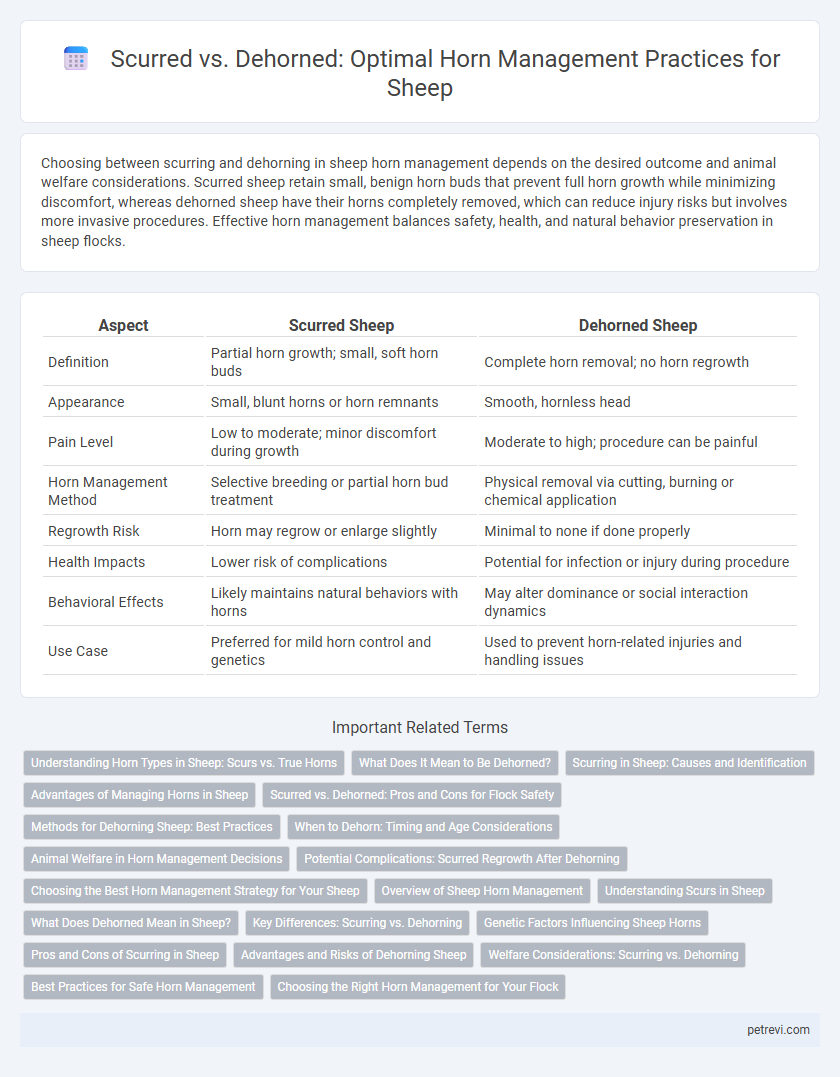Choosing between scurring and dehorning in sheep horn management depends on the desired outcome and animal welfare considerations. Scurred sheep retain small, benign horn buds that prevent full horn growth while minimizing discomfort, whereas dehorned sheep have their horns completely removed, which can reduce injury risks but involves more invasive procedures. Effective horn management balances safety, health, and natural behavior preservation in sheep flocks.
Table of Comparison
| Aspect | Scurred Sheep | Dehorned Sheep |
|---|---|---|
| Definition | Partial horn growth; small, soft horn buds | Complete horn removal; no horn regrowth |
| Appearance | Small, blunt horns or horn remnants | Smooth, hornless head |
| Pain Level | Low to moderate; minor discomfort during growth | Moderate to high; procedure can be painful |
| Horn Management Method | Selective breeding or partial horn bud treatment | Physical removal via cutting, burning or chemical application |
| Regrowth Risk | Horn may regrow or enlarge slightly | Minimal to none if done properly |
| Health Impacts | Lower risk of complications | Potential for infection or injury during procedure |
| Behavioral Effects | Likely maintains natural behaviors with horns | May alter dominance or social interaction dynamics |
| Use Case | Preferred for mild horn control and genetics | Used to prevent horn-related injuries and handling issues |
Understanding Horn Types in Sheep: Scurs vs. True Horns
Scurs in sheep are small, loose horn-like growths that are typically less developed and not firmly attached to the skull, unlike true horns which grow directly from the skull with a solid bony core covered by keratin. True horns in sheep provide natural protection and display characteristics such as continuous growth and a hardened base, whereas scurs result from partial genetic expression or incomplete removal during dehorning. Accurate identification of scurs versus true horns is crucial for proper horn management strategies, including decisions about dehorning practices and genetic breeding programs.
What Does It Mean to Be Dehorned?
Being dehorned in sheep refers to the surgical removal of horn buds or horns to prevent horn growth, which reduces injury risks to other animals and handlers. This procedure is typically performed on young lambs before horn development becomes established, ensuring smoother flock management and easier handling. Dehorning also helps minimize damage to facilities and decreases aggressive behavior linked to horned sheep.
Scurring in Sheep: Causes and Identification
Scurring in sheep refers to the presence of small, loose horn-like growths that differ from fully developed horns and can result from incomplete or partial horn removal. Causes of scurring include genetic factors, improper dehorning techniques, or regrowth following horn bud removal, often leading to irregular horn tissue formation. Identification involves observing small, soft, or loose horn tissue around the horn buds, which may cause discomfort or affect flock management practices.
Advantages of Managing Horns in Sheep
Managing sheep horns through scurring or dehorning prevents horn-related injuries and reduces risks during handling, improving animal welfare and farm safety. Controlled horn growth minimizes damage to fences, feed troughs, and pen mates, enhancing structural integrity and flock harmony. Proper horn management also facilitates easier shearing and health inspections, boosting overall farm efficiency and productivity.
Scurred vs. Dehorned: Pros and Cons for Flock Safety
Scurred sheep retain small, blunt horn growths, reducing injury risks within the flock while maintaining natural horn characteristics, but may still cause minor abrasions or challenges in confined spaces. Dehorning removes horn buds entirely, virtually eliminating horn-related injuries and facilitating easier handling, yet it involves a more invasive process with potential for pain and stress to the animals. Selecting between scurred and dehorned management balances welfare concerns and flock safety, considering factors like breed, handling practices, and the risk of horn-related aggression.
Methods for Dehorning Sheep: Best Practices
Effective dehorning methods for sheep include disbudding and horn tipping, both aimed at reducing horn growth safely and minimizing stress. Disbudding is best performed within the first two weeks of life, utilizing hot iron cautery to destroy horn buds before they attach to the skull. Proper hygiene, pain management, and skilled handling during the procedure are crucial to prevent infection and ensure rapid healing.
When to Dehorn: Timing and Age Considerations
Dehorning sheep is most effective and least stressful when performed within the first few weeks of life, typically between 1 to 2 weeks of age before horn buds firmly attach to the skull. Early dehorning minimizes pain, reduces complications, and prevents aggressive horn growth that can cause injuries. Delaying beyond 3 weeks increases the risk of excessive bleeding and infection, making timely intervention critical for optimal horn management.
Animal Welfare in Horn Management Decisions
Scurred sheep exhibit partially developed horn growth, which can reduce injury risk compared to fully horned individuals, making them a consideration in welfare-focused horn management. Dehorning, the complete removal of horns, is often performed to prevent harm to other animals and handlers but must be balanced against pain and stress caused during the procedure. Implementing pain management strategies and considering breed-specific horn tendencies are essential steps to optimize animal welfare in horn management decisions.
Potential Complications: Scurred Regrowth After Dehorning
Scurred regrowth after dehorning can lead to irregular horn development in sheep, increasing the risk of injury to the animal or others. This condition often results from incomplete horn bud removal or improper technique during dehorning, causing partial horn tissue to regenerate abnormally. Managing scurred regrowth requires careful monitoring and may necessitate additional interventions to prevent complications such as infections or behavioral issues related to horn discomfort.
Choosing the Best Horn Management Strategy for Your Sheep
Choosing between scurring and dehorning for sheep horn management depends on breed, age, and farm goals. Scurring allows partial horn growth, reducing injury risks while maintaining natural defense traits, whereas dehorning removes horns entirely to prevent damage and facilitate handling. Evaluating animal temperament, safety concerns, and long-term welfare ensures the best strategy for effective horn management and flock health.
Scurred vs Dehorned for Sheep Horn Management Infographic

 petrevi.com
petrevi.com